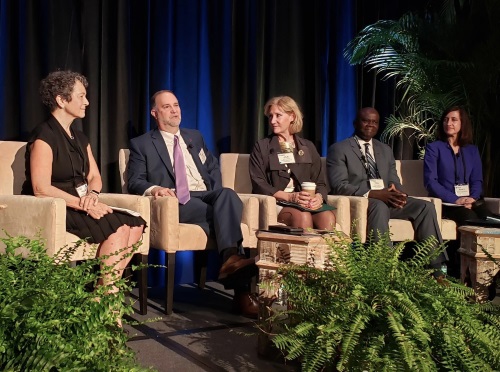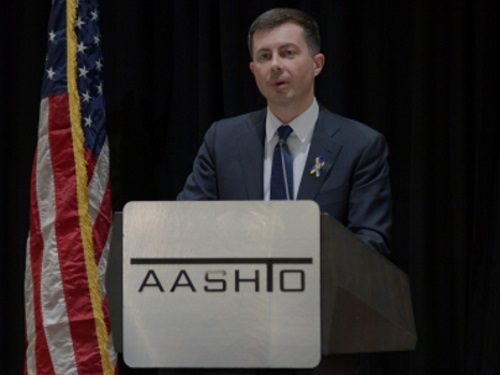How should state departments of transportation use funds from the $1.2 trillion Infrastructure Investment and Jobs Act or IIJA to improve the nation’s transportation systems for the future?
[Above photo by AASHTO]
That question formed the basis for a “knowledge session” sponsored by AECOM during the American Association of State Highway and Transportation Officials 2022 Washington Briefing on March 2.

“There are vast and profound implications for the United States for not having adequate infrastructure,” noted Shailen Bhatt, senior vice president for global consulting firm AECOM, who served as the panel’s moderator.
Yet Bhatt said it is critical that state DOTs “step back” from the tactical day-to-day needs of project funding to get a more “strategic sense” of the impact of projects 10 to 20 years from now.
“I think electrification and broadband are two key focal points of the IIJA, for example,” he explained. “But we have task, what is the vision that gets us there? How do we end up in the place we want to go?”
The state DOT executives participating on the panel provided a variety of answers to those questions.

Jim Gray, secretary of the Kentucky Transportation Cabinet, channeled Albert Einstein in terms of how state DOTs need to alter their strategic planning mindset: “We can’t solve problems by using the same kind of thinking we used when we created them,” he said.
Diane Gutierrez-Scaccetti, commissioner of the New Jersey Department of Transportation, echoed Gray’s point by noting that “we have to think differently” in terms of finding ways to improve the movement of people and goods.
“We are not planning for us – we are planning for our grandchildren,” she stressed. “We need to use our dollars across all modes to create different opportunities for travel and goods movement. There are many things we can do to make life better while improving safety and efficiency.”
Gutierrez-Scaccetti pointed to climate change and its impact on transportation infrastructure as one of those areas where “different thinking” is required.
“The IIJA contains $46 billion for resiliency programs along with new data-driven tools to guide investments of additional resiliency funding to maintain [our infrastructure] in a state of good repair,” she explained.
“We need to use data to look at our environmental ‘hot spots’ – how climate change affects our shorelines and thus how we build out our projects,” Gutierrez-Scaccetti said. “That’s part of looking to the future. We need to look at every project we will build using climate hazard visualization tools. We have to look at long range planning. Because if we do not start asking questions today, 10 to 15 years from now, we won’t have options to address climate impacts.”

Roger Millar, secretary of the Washington State Department of Transportation and AASHTO’s 2021-2022 vice president, said that is one reason why his agency is “focusing everything we do” through a “climate and equity lens.”
That “future-forward” focus is also critical to saving money as well, he said. “Putting repairs off now incurs the need for more expensive repairs in the future – especially if we are pushing past the expected life of a transportation asset, be it a highway, bridge, transit facility, or ferry boat,” Millar noted. “The IIJA gives us a down payment for what we’re doing in that regard. It is definitely going to help.”
Toks Omishakin, the former director of the California Department of Transportation and now secretary of the California State Transportation Agency, added that new types of funding from the IIJA offer a chance for state DOTs to reimagine their role in the transportation system.
He pointed to the $1 billion “Reconnecting Communities” program within the IIJA as an example of how state DOTs can change their approach to transportation issues. That program seeks to reconnect communities divided by transportation infrastructure – funding the planning, design, demolition, and reconstruction of street grids, parks, or other infrastructure in the process.
“That is a deposit on a commitment to address the past implications of infrastructure construction,” he said. “If we go beyond what the manual says, if we just go below the surface, we would know the importance of reconnecting local communities. That means we cannot just be focused on infrastructure, but rather on the communities it serves. This sometimes get lost in the engineering process.”



